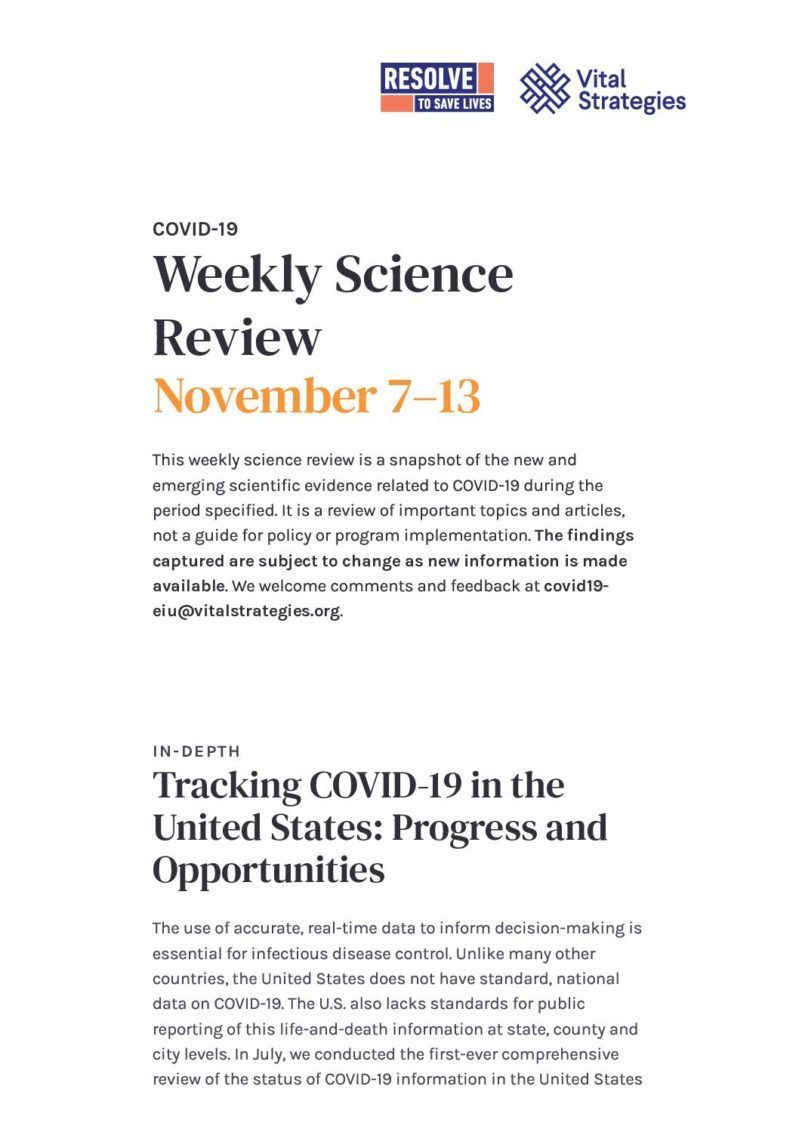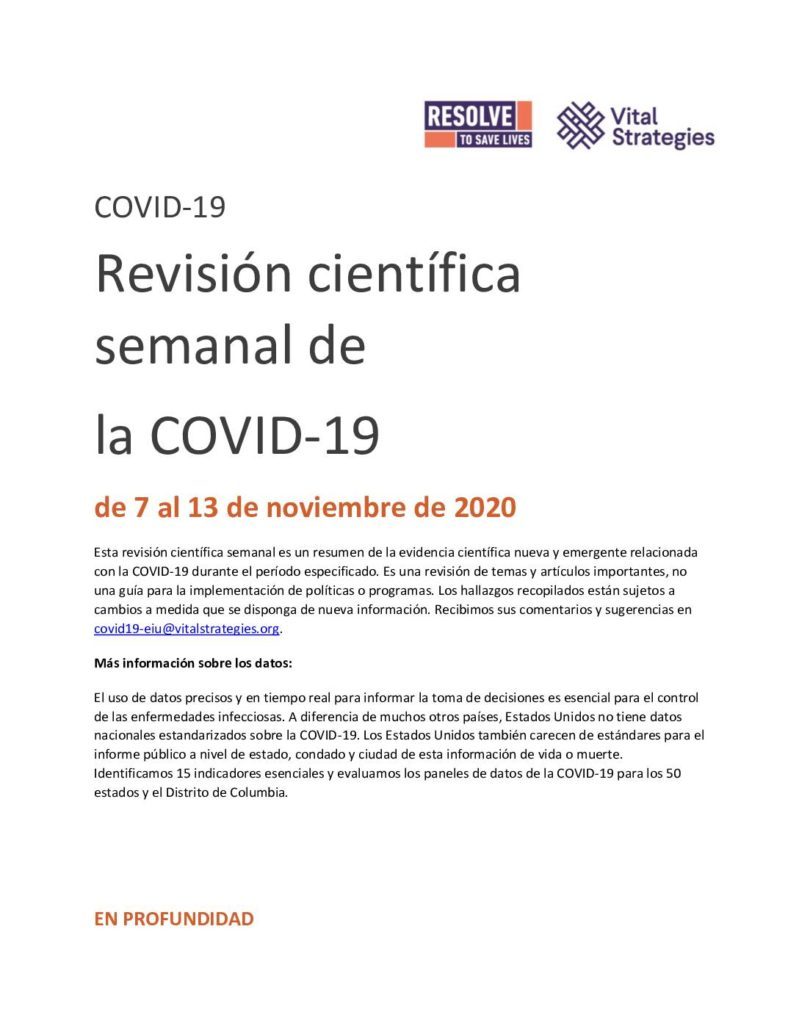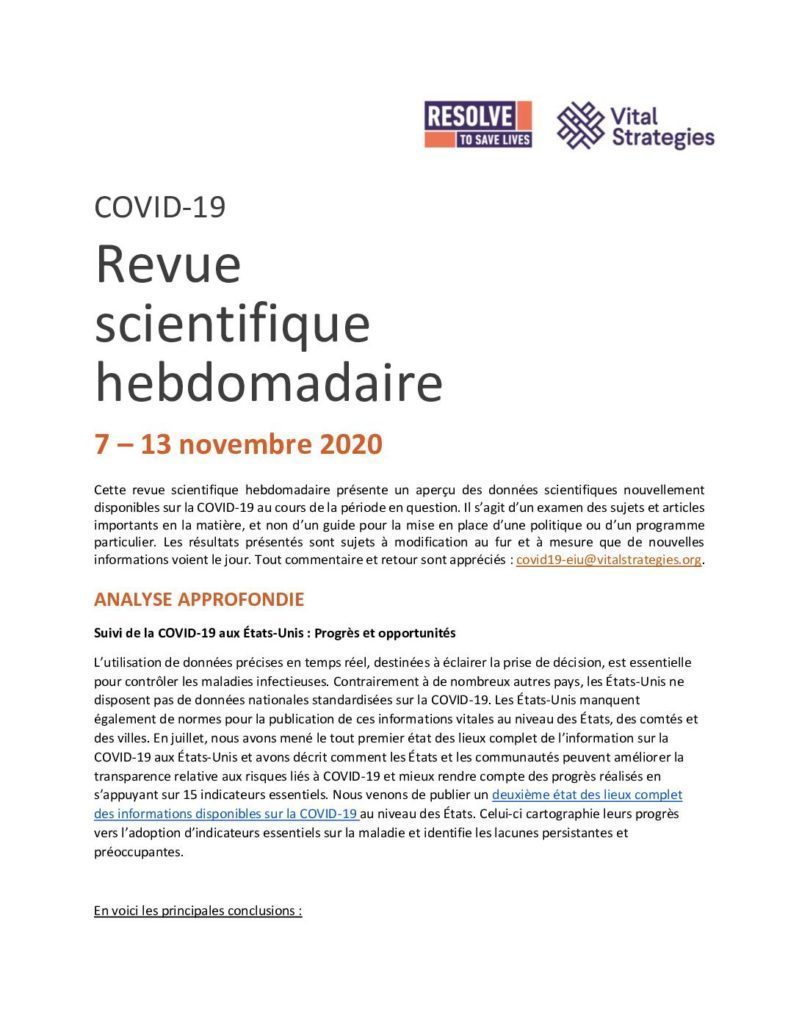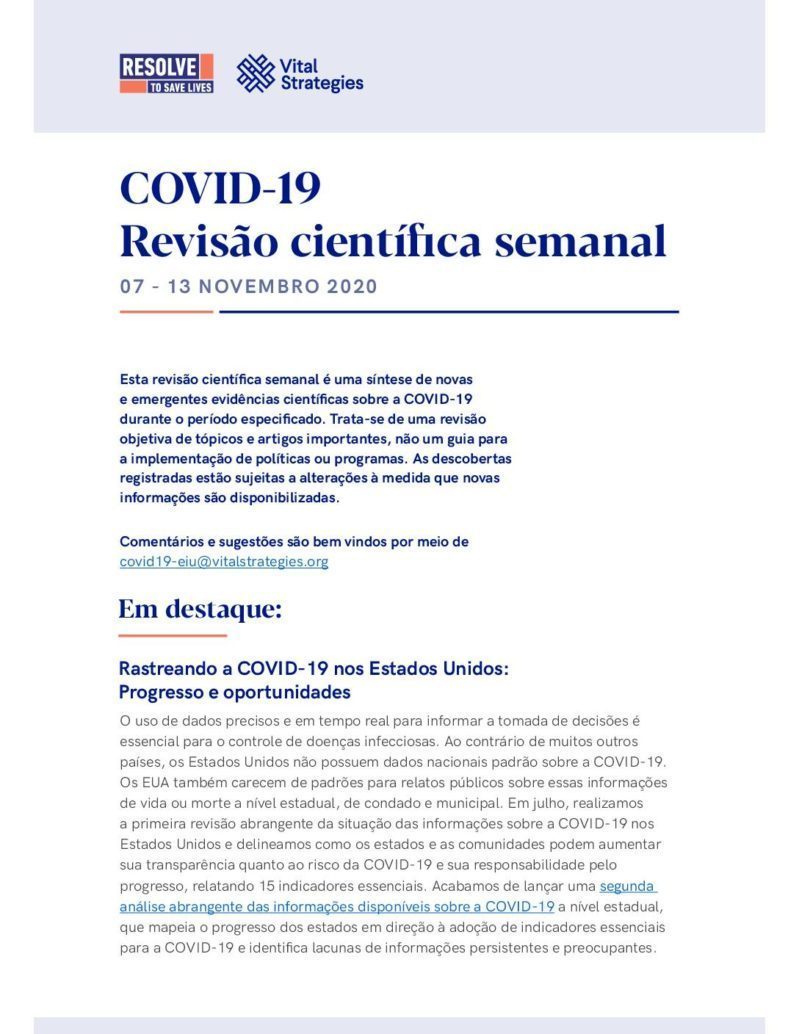In-depth
Tracking COVID-19 in the United States: Progress and Opportunities
The use of accurate, real-time data to inform decision-making is essential for infectious disease control. Unlike many other countries, the United States does not have standard, national data on COVID-19. The U.S. also lacks standards for public reporting of this life-and-death information at state, county and city levels. In July, we conducted the first-ever comprehensive review of the status of COVID-19 information in the United States and outlined how states and communities can increase transparency about risk of COVID-19 and accountability for progress by reporting on 15 essential indicators. We have just released a second comprehensive review of available COVID-19 information at the state level which maps states’ progress toward adopting essential COVID-19 indicators and identifies persistent and concerning gaps.
Key findings include:
Limited but encouraging improvements show that the U.S. can do better. The average COVID-19 data dashboard scored 31% (up from 21% in July). For 14 of the 15 essential indicators, there is at least one state whose reporting meets the gold standard. Reporting on outbreaks in congregate facilities (including long-term care facilities, correctional facilities and homeless shelters), test positivity, and occupancy proportion of ICU beds showed the greatest improvement.
Failure to break down numbers by age and race/ethnicity over time hides important trends. Essential indicators such as cases, tests, hospitalizations and deaths are not stratified by subgroup or over time in many states. This means there is critical information missing on how different communities and demographic groups are being disproportionately impacted, limiting public awareness, accountability and progress.
Reporting on case investigation and contact tracing remains unacceptably poor. There are two crucially important indicators: how long it takes to get infectious people isolated and what proportion of cases arise from among quarantined contacts. No state fully meets criteria for reporting on the time from when a test is performed (specimen collection) to when people confirmed to be infected are isolated. Only two dashboards (Washington, D.C. and Vermont) fully meet criteria for reporting on the crucially important indicator of the percentage of new cases that come from quarantined contacts. These gaps hamstring the public’s ability to understand the performance of local contact tracing efforts, limit sharing of best practices between states, and delay life-saving improvements. Although contact tracing may need to be scaled back in the context of explosive spread of the virus, case investigation and contact tracing services need to be continuously improved so that more of society can be opened sooner and safer.
With the emergence of rapid antigen testing, tracking tests performed and their results has become increasingly complex, and reporting has not kept up. Most (58%) state dashboards do not differentiate between faster, less accurate antigen tests, and molecular (PCR) tests. Failure to report the results of antigen testing may leave communities unaware of local transmission and outbreaks that have not been confirmed by molecular testing.
Read the full report, explore a live interactive map of results, and access an essential indicators dashboard kit here.
Household transmission of COVID-19
There is a growing body of evidence that shows that the household is one of the places with the highest risk of secondary infection. For months, we have received messaging about actions to take in public such as physical distancing, mask use and hand hygiene, while the home has been largely left out of discussion about public health and social measures to reduce transmission. However, the home is not an inherently safe environment from COVID-19. SARS-CoV-2, the virus that causes COVID-19, spreads primarily when respiratory particles carrying virus that are expelled by an infected person though breathing, talking, singing, coughing or sneezing are then inhaled by another person. Some of the riskiest settings for spread are indoor confined spaces where people have close contact and conversations within 6 feet of one another. Therefore, it is understandable that a household may be an especially high-risk setting if someone within the household has COVID-19. Most people who get COVID-19 do not develop severe illness. Instead, they may be completely asymptomatic, or they may have mild or moderate symptoms that do not require medical care. People with mild, moderate and asymptomatic cases are advised to stay home and limit contact with others in order to minimize disease transmission. Without adequate precautions in the home or isolation outside the home (as done in many countries in Asia), this can lead to transmission to other household members, including adults and children, at alarmingly high rates.
Researchers calculate or estimate a household secondary attack rate (SAR)—the probability that an exposed susceptible person in the same household as an index case develops disease—in different ways. In the earlier months of the pandemic, much of this research was based on retrospective analysis of contact tracing efforts or through prospective symptom monitoring of household contacts. These analyses may have underestimated the true household SAR due to incomplete contact tracing, false negatives from testing household contacts too soon and their inability to capture asymptomatic cases, since protocol was to only test contacts when they developed symptoms, and because many studies did not include antibody tests. Nevertheless, studies from China, Italy, the U.S. and the U.K. published by July 2020, were already estimating the household SAR to be between 25% and 45%. In August, a group of researchers posted a preprint meta-analysis of 40 studies looking at rates of transmission within households. They combined these studies to formulate a more robust estimate of the household SAR and estimated that the household SAR for COVID-19 overall was 19%, with individual studies ranging from 4% to 45%. Based on this finding, they were able to conclude that household and family contacts were at higher risk for secondary infection than other types of contacts. Factors associated with higher SAR within households included physical contact, sharing a vehicle, sharing eating and living spaces, and sharing a meal. Factors associated with lower household SAR included use of masks by the index case, use of masks by household contacts, and isolating the index case upon illness onset. In their review, they also found that secondary infection was more common in adults than in children, and that the spouse of the infected person was more likely than other family contacts to become infected.
To address asymptomatic infections and false negatives from poorly timed testing and symptom monitoring, one preprint study used modeling to adjust previously published rates of household SAR. They found that after pooling studies and adjusting them using their model, household SAR increased from around 20% to approximately 30%.
More recently, the results of systematically designed prospective studies with more refined testing and monitoring practices are estimating household SAR of greater than 50%. In a Morbidity and Mortality Weekly Report from the U.S. Centers for Disease Control and Prevention, researchers published the results of an assessment of household SAR in which all household contacts were asked to submit daily samples for testing, in contrast to some earlier studies where contacts were tested at a single time point or only monitored for symptoms. In this study, the secondary infection rate was 53%, and was similar in adults and children, but was highest in the older age group (62% for those 50 years or older). Secondary infections occurred early, usually within 5 days of the index case’s diagnosis, with a proportion (54/191, 28%) of household contacts testing positive at the time of enrollment without knowing they had already been infected, When these concurrent infections were not included in the analysis, the household SAR was 35%. Almost a third of the index patients in this study reported sleeping in the same room as a household contact after illness onset, and 40% reported spending at least 4 hours in the same room as other household members after illness onset, indicating that index cases were not optimally isolating.
There is definitive evidence that the household environment contributes to significant secondary transmission of COVID-19, but there may be missed opportunities to reduce this type of transmission. In a study designed to capture both symptomatic and asymptomatic secondary household infections in the U.S., researchers found a household SAR of 29%. They also noted that many people did not change their behaviors or adopt additional measures to decrease the chance of secondary infection upon enrollment in the study, with only half of index cases using a separate bathroom and only 57% of them wearing a mask in the home. Isolation and mask use have been associated with reduced secondary infection in other studies, and continue to be among the top recommendations from health agencies as ways to reduce transmission inside the home once a household member develops symptoms or is diagnosed with COVID-19.
There are broader implications from these data on household SAR and COVID-19 transmission. Gatherings inside homes with family and friends who may not live in the same household also carry a high risk of disease transmission, especially if precautions are not taken. In fact, some of the studies looking at household transmission simultaneously evaluated SAR among non-household friends and family and found that this group was also at heightened risk of secondary infection. In addition, the mixing of younger and older adults, as is likely to happen during family gatherings, puts a disproportionate risk on older family members, who may be more likely to become infected and are much more likely to have severe complications from the disease. One preprint study from Norway showed a secondary infection rate of 72% for those over 60 years old compared to 47% overall. The home is not inherently safe from COVID-19. Precautions including masks and distancing are needed when non-household members visit for social gatherings, and isolation of cases and mask use by all household members is of paramount importance when a case is identified in the household.
FAQs
What is vaccine efficacy?
Two vaccine makers made headlines this month after announcing their COVID-19 candidate vaccine efficacy. Pfizer, and its German partner BioNtech, announced an overall vaccine efficacy of 95% from their phase 3 vaccine trial. Moderna made a similar announcement, reporting a vaccine efficacy of 94.5% based on preliminary results from its trial. These announcements were celebrated widely at a time when sharp increases in COVID-19 cases, hospitalizations and deaths are being seen in many parts of the world, including in the U.S.
Vaccine efficacy refers to how well a vaccine works in ideal research conditions. It is related to vaccine effectiveness, which refers to how well a vaccine works in real-world conditions. Both are calculated using a relatively simple mathematical equation to determine how well a vaccine protects those who receive it compared to those who do not receive the vaccine. The equation is as follows:
In other words, vaccine efficacy is the percent disease is reduced among those who have received the vaccine compared to those who have not. The Pfizer and Moderna announcements mean that we expect the incidence of COVID-19 among those who receive their vaccine to be reduced by about 95% under ideal circumstances.
Although the first doses of vaccine are expected to be delivered before the end of 2020 to those at highest risk of exposure or serious illness, it will be months before mass vaccination occurs. Nevertheless, the results from these front-running vaccines are encouraging. Not enough time has passed since vaccination to know how long protection from these vaccines will last. Both of these vaccines require two doses.
Weekly Research Highlights
Note: US CDC also publishes a COVID-19 Science Update
Characteristics of Hospitalized COVID-19 Patients Discharged and Experiencing Same-Hospital Readmission — United States, March–August 2020
(MMWR, Nov. 13)
-
Researchers at the U.S. Centers for Disease Control and Prevention analyzed medical records from more than 125,000 unique patient hospitalizations for COVID-19 in the Premier Healthcare Database for information on hospital discharge and readmission, clinical course of the index COVID-19 hospitalization and demographic factors.
-
Overall, 85% of patients survived the index COVID-19 hospitalization. Of the 106,543 survivors, 9% required readmission to the same hospital within two months of the index COVID-19 hospitalization. Medical conditions associated with increased odds of readmission were chronic kidney disease (OR 1.63), heart failure (OR 1.58), chronic obstructive pulmonary disease (OR 1.35) and diabetes (OR 1.21). A hospitalization for any reason within three months prior to the index COVID-19 hospitalization was strongly associated with requiring readmission after discharge from the COVID-19 hospitalization (OR 2.61). Those over 65 years old were also independently at increased risk of needing readmission within two months, as were those who were discharged to a skilled nursing facility (OR 1.37).
-
It is possible that this study underestimated the true readmission rate, since it only evaluated same-hospital readmission and it is possible that people may have chosen to seek care at a different facility. Other limitations included the possibility of misclassification error secondary to the use of ICD codes for case ascertainment.
Effectiveness of Adding a Mask Recommendation to Other Public Health Measures to Prevent SARS-CoV-2 Infection in Danish Mask Wearers: A Randomized Control Trial
(Annals of Internal Medicine, 18 Nov. 2020)
-
The intervention lasted one month. During the time of the intervention, recommendations in Denmark for COVID-19 prevention included physical distancing, limiting contacts and hand-washing. Cafes and restaurants were closed for most, but not all, of the study period. There were 3,030 participants in the masked group and 2,994 in the control group; dropout was high (19%) and slightly higher in the intervention group (21 v. 18%). Participants were given antibody tests on study entry and the primary endpoint was a positive antibody test, PCR test or a hospital-based COVID-19 diagnosis.
-
Adherence to mask use was moderate with 46% reporting that they followed the mask instructions as recommended, another 47% predominantly as recommended and 7% not following them .
-
Overall, 42 participants in the masked group (1.8%) and 53 in the control group (2.1%) contracted COVID-19 during the study period. While the risk of contracting COVID-19 was lower in the mask-wearing group (OR = 0.82; 95% CI 0.54 to 1.23), it did not attain statistical significance in the main analysis or any of the sensitivity analyses.
-
In determining the sample size needed for this trial, investigators hypothesized that masks would reduce the risk of COVID-19 infection by 50%.The results of the trial are consistent with a real, but smaller effect on transmission; however, no conclusions can be made about that given that the study was not powered to examine this.
- A major limitation of this trial was the reliance on antibody testing as the main outcome measure in the context of relatively low incidence of COVID-19. The test used by the study has a sensitivity between 97.5 and 99.5% which could mean that a meaningful percentage of positive tests could be falsely positive and evenly distributed between the intervention and control groups, biasing the study toward the null.
Robust SARS-CoV-2-specific T-cell Immunity is Maintained at 6 months Following Primary Infection
(BioRxiv preprint)
-
Blood samples were obtained from 100 convalescent donors six months after SARS-CoV-2 infection. Researchers used viral proteins from SARS-CoV-2 to stimulate cells from donors and to assess the magnitude of the SARS-CoV-2-specific response. They performed analysis of intracellular proteins produced in response to infection (cytokines) to assess for a response specific to SARS-CoV-2. Cellular responses were compared to antibody levels in donor samples that had been obtained monthly for six months.
-
Although 56% of donors had been symptomatic, none had required hospitalization from COVID-19. Cellular responses to SARS-CoV-2 proteins were higher among those with symptomatic infections.
-
A cellular response specific to SARS-CoV-2 was observed in samples from all donors. The magnitude of the cellular response was greater among those with higher peak antibody levels and among those with less decline in antibody levels over six months.
-
The degree to which observed immunologic responses correlate with protection against infection or protection against severe infection was not assessed in this study.
Suggested citation: Cash-Goldwasser S, Kardooni S, Cobb L, Bochner A, Bradford E and Shahpar C. In-Depth COVID-19 Science Review November 7 – 13, 2020. Resolve to Save Lives. 2020 November 20. Available from https://preventepidemics.org/covid19/science/review/








